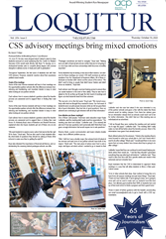 Justine DiFilippo
Justine DiFilippo
The threat of chemical and biological warfare has been hanging over the nation’s head since tragedy struck on Sept. 11. The attack on the World Trade Center and Pentagon has heightened America’s sense of fear. Americans are now, for the first time, full of suspicions regarding their safety. From that day on, the nation has been collectively asking, “What will happen next?”
The fear, however, that is consuming people is unknown. Is chemical or biological warfare a realistic threat and if so, are we prepared? In the days following the attack army/navy stores weren’t able to keep gas masks on the shelves. The sales of the antibiotic Cipro, a drug that can be used to help reverse the effects of anthrax, have skyrocketed. The gas masks, however, will prove to be “Practically useless in the event of a chemical or biological attack,” according to Detective Thomas Farrell, Suffolk County, Long Island Arson Investigator. “Every known chemical needs a separate filter to be placed in the gasmask. If your filter blocks anthrax but we’re hit with plague, the mask means nothing,” Farrell said. Some of the chemicals can also be absorbed through skin and eyes.
Historically, the United States has never had to deal with bio-terrorism. Terrorists have been and are, experimenting with both chemical and biological warfare. Outside of bin Laden’s training grounds in Jalalabad, several small animals have been found dead due to lethal poisoning as reported in the Oct. 8 issue of Newsweek. Internationally in 1995, sarin, a nerve gas developed during World War II, was released in a Tokyo subway station. The attack, lead by cult leader Aum Shinrikyo, killed 12 people.
But the threat of biological or chemical warfare is unclear. Dr. Jolyon Girard, professor of history and political science, said, “If one has access to the materials then it is a conceivable approach.” If terrorists like bin Laden decided to go forth with these types of attacks they must be aware of the consequences. “The reprisal of the United States could be nuclear,” Girard said. “It’s a very dangerous way to engage in war.”
Dr. Sherry Fuller-Espie, chair of the science department and assistant professor of biology, said “No one knows how real the threat is,” and that “a clear understanding of what is and what is not possible is very important.” When biological and chemical warfare is being discussed in the capacity that it has been in recent weeks, people must realize that there is a difference between the two.
Chemical agents were first being used during World War I. The agents are much easier to obtain. Cyanide for instance is a widely used tool for cleaning metals. The largest problem that terrorists face with both chemical and biological warfare is finding a way of “weaponizing” it. This means they must first find a way to keep the samples active and develop a system of dispersal. The Tokyo subway sarin attacks were done with plastic baggies full of the gas that were popped with either pins or umbrella points. It sounds very archaic but so does flying a commercial airliner into an office building. Another downside that terrorists face is the short life span of the chemicals. After the sarin was exposed to the air of the subway it began to lose its efficacy.
Biological materials like anthrax, botulinum and smallpox are extremely difficult to obtain. According to FBI reports bin Laden has tried, without any success, to obtain some of these materials. Some biological agents, unlike chemical agents, can be spread throughout the public. Smallpox for example is a highly infectious biological disease and since a small quantity of vaccines exist, a contaminable disease like smallpox would be very difficult to control. On Oct. 5, a 63-year-old Florida man died from anthrax poisoning. At first there were no criminal suspicions, but after a second man in the same building was found with the anthrax bacteria in his nose, the attorney general has sealed the building. The Centers for Disease Control has been brought in to investigate. The disease, biological, causes respiratory failure but can be treated with antibiotics if it is caught in an early stage. The problem with anthrax poisoning is that it is pathogenic. “When anthrax spores germinate in the body, they can produce a capsule around themselves in order to evade the body’s phagocytic white blood cells,” said Fuller-Espie, enabling the disease to spread faster throughout the body. Anthrax cannot be passed from one person to another. Detective Farrell doubts the likelihood of a biological attack due to the fact that the materials are so heavily controlled.
In either the case of biological or chemical warfare, immense quantities would be needed in order to cause mass destruction. But Farrell says that that is not always the intent on the terrorist’s part. “The goal of the terrorist is to disrupt normal, daily life,” says Farrell “If someone were to leave a container containing hazardous chemicals in the King of Prussia Mall, the causalities would not be outstanding, but people would begin to question ever leaving the house.”


